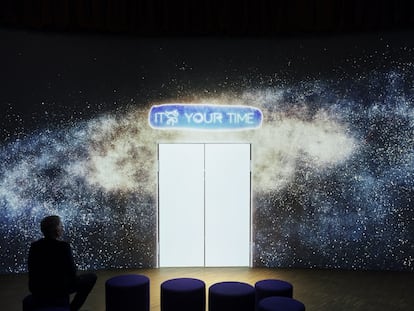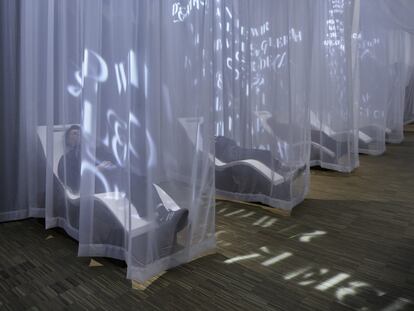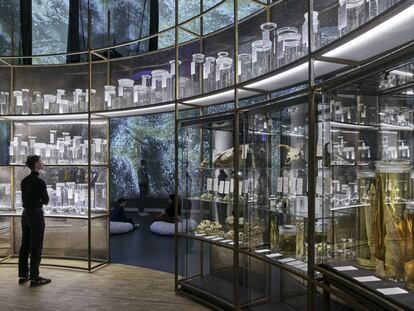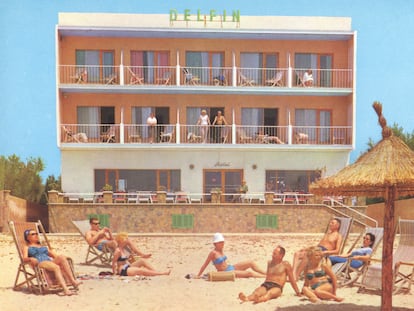On a walk through the many forms of death
An exhibition in Berlin explores how humans across cultures understand their mortality, what a good death is and what we leave behind

“When it comes to death, we know that laughter and tears are pretty much the same thing,” the author Sherman Alexie once wrote. But with coronavirus deaths still fresh in our memory, the war in Ukraine, the humanitarian crisis in the Mediterranean and the climate emergency, no one seems to have reason to laugh or celebrate. It may not be true that humans are “the only beings who know that they will die,” but that’s the message that ends the audiovisual prologue of the exhibition in_finite. Living with Death at the Humboldt Forum in Berlin. The multimedia exhibition questions how we should handle our mortality, what a good death is and what we leave behind when we go.
It brings together an ecumenical collection of voices, including an imam, a Protestant pastor, an expert in Yoruba culture, a synagogue cantor and a representative of Berlin’s Sri Ganesha Hindu temple. In audio fragments, they share their religions’ respective ideas about death. The CEO of a company dedicated to cryopreserving bodies represents the promise of technological immortality. (He admits that it is currently possible to freeze a person, but not to bring them back to life. Even so, he considers freezing yourself a practical decision.)

They aren’t the only voices in the show. The exhibition imitates a theater set, with white cloths hanging from the ceiling, projections and a room equipped with the supplies for the ghusl mayyit, the Muslim ritual cadaver bath. Visitors can listen to a criminologist talk about how bodies are “an oasis for insects, bacterias and animals,” a reminder of the material transformations that make life possible.
Also present are the testimonies of 12 professionals from different cultures who share their experiences accompanying dying people. In a specially designed cabin, a robotic voice narrates in real-time the physical and chemical changes in the body — ”Your body,” it says — at the moment of death. Good news, by the way: we die in a “fireworks show” provoked by the liberation of great quantities of dopamine, serotonin, endorphins and oxytocin.

The curators demonstrate that, despite its reputation as the great equalizer, death is subject to many different interpretations. Some Muslim mystics traveled with their burial shrouds as a turban so as not to forget their mortality. For Hindus, life is an opportunity to free themselves from the wheel of time and reincarnations. It is the “final frontier” for technologists and an opportunity to “repair the world” with our actions, according to some Jews. But what is really surprising is the similarities in how different cultures approach death.
The exhibition continues with texts on death, dying and mourning by Audre Lorde, Chimimanda Ngozi Adichie and Abdulrazak Gurnah. A program of activities includes public gatherings with forensic experts and undertakers, workshops, film screenings, activities for children and the celebration of Mexican Day of the Dead. And there are two more rooms: in the first, half a dozen charts show the life expectancies and causes of death in a representative sample of countries. They also show the number of deaths in ongoing armed conflicts, the number of journalists murdered between 2012 and 2022 and those who have died in recent years trying to cross borders.
The final room is dedicated to the work of forensic anthropologists, who try to identify dead migrants. Some of the objects they carry are projected in the room, whose silence mimics the silence of authorities when faced with questions about migrant deaths and their responsibility.

The exhibition is full of intriguing small details, from the color of the garments with which some Buddhist traditions bury their dead, to information such as the fact that in Europe it is prohibited to bury nude cadavers and scatter ashes in public places.
On a morning in July, the exhibition is full of pregnant women and people with baby strollers. According to the results of a poll that the visitor can take at the beginning of the tour, which is updated in real-time, 63% of visitors are afraid of dying, but 70% do not fear a posthumous punishment. Some 69% are in favor of organ donation and 80% of euthanasia, and only 53% believe in life after death.
In the words of Patrice Dwyer, who defines herself as a “death doula” and whose words appear alongside those of others who accompany the dying, “we don’t have to fear death, but not having lived.” The exhibit’s curators and visitors seem to share her opinion. As the actress Mae West said, “you only live once, but if you do it right, once is enough.”
Sign up for our weekly newsletter to get more English-language news coverage from EL PAÍS USA Edition
Tu suscripción se está usando en otro dispositivo
¿Quieres añadir otro usuario a tu suscripción?
Si continúas leyendo en este dispositivo, no se podrá leer en el otro.
FlechaTu suscripción se está usando en otro dispositivo y solo puedes acceder a EL PAÍS desde un dispositivo a la vez.
Si quieres compartir tu cuenta, cambia tu suscripción a la modalidad Premium, así podrás añadir otro usuario. Cada uno accederá con su propia cuenta de email, lo que os permitirá personalizar vuestra experiencia en EL PAÍS.
¿Tienes una suscripción de empresa? Accede aquí para contratar más cuentas.
En el caso de no saber quién está usando tu cuenta, te recomendamos cambiar tu contraseña aquí.
Si decides continuar compartiendo tu cuenta, este mensaje se mostrará en tu dispositivo y en el de la otra persona que está usando tu cuenta de forma indefinida, afectando a tu experiencia de lectura. Puedes consultar aquí los términos y condiciones de la suscripción digital.
More information
Archived In
Últimas noticias
Russian ultranationalism, inflamed by the killing of the hooligan commander ‘Spaniard’
The relentless struggle between factions deepens the Sinaloa war: bodies in coolers and a surge in homicides
‘Doctor Death’, the journalist who has witnessed 105 executions in Florida
Being trans or gay in a migrant detention center: ‘They call me faggot, queer, bitch’
Most viewed
- The low-cost creative revolution: How technology is making art accessible to everyone
- Christian Louboutin: ‘Young people don’t want to be like their parents. And if their parents wear sneakers, they’re going to look for something else’
- All the effects of gentrification in one corner of Mexico’s Colonia Roma
- Liset Menéndez de la Prida, neuroscientist: ‘It’s not normal to constantly seek pleasure; it’s important to be bored, to be calm’
- Christmas loses its festive spirit: ICE fears cast shadow over religious celebrations











































